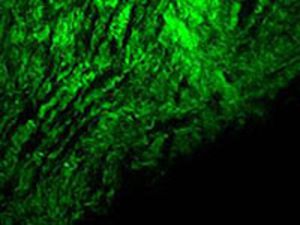Ultrafast FemtoFiber Lasers for SHG Microscopy
Ultrafast Lasers for SHG Microscopy / Second Harmonic Imaging Microscopy
In a SHG process the interaction of two photons with a nonlinear material creates a new photon having twice the energy and therefore half the wavelength of the incident light. This process was first observed on crystalline quartz in 1961, only years later was it also applied to investigate biological specimens. Since then second harmonic imaging microscopy (SHIM) has evolved to an established method to visualize structure and function of cells and intact tissueThis technique combines the enhanced optical resolution, due to the shrinked effective excitation volume and high penetration depth with the reduced optical destruction by using fs- and ps- modelocked long (NIR and IR) wavelength excitation.
In two-photon microscopy, the probability to excite the SHG is very low and depends on the square of the intensity of the illumination light only in the high intensity region of the excitation focus, the light intensity is high enough for these processes to occur. Therefore modelocked ultrafast lasers are ideally suited to generate sufficiently high intensities at moderate average excitation powers to prevent the sample material from degradation.
Second and Third harmonic microscopy
The second harmonic and third harmonic microscopy works without any sample labeling like in conventional fluorescence microscopy. This means that no fluorescent dyes have to be used to label the structure of interest. This fact implies that the molecular structure of the imaged specimen remains unchanged and also its metabolism is not altered. These properties make SHG microscopy and ideal tool, especially for live-cell imaging.
However, second harmonic generation requires a non-centrosymmetric molecular structure and only highly ordered structures show sufficiently high cross-sections for SHG. In biological tissues mainly collagen (an extracellular protein), microtubules and myosin (intracellular proteins) produce sufficiently strong SHG signals for imaging. An application for SHG microscopy is for example non-invasive high resolution imaging of myosin in living muscle cells or the analysis of structural changes of the extracellular matrix.
SHG imaging system
The most common layout is a laser-scanning microscope (LSM) equipped with a mode-locked ps- or fs-pulsed laser sources emitting light at NIR- and IR- up to the mid-IR region. In the LSM the incident laser beam is focused via a high NA objective onto the sample. The scanning mirrors in the microscope change the orientation of the beam so that the focal point scans the specimen in the lateral direction. This way the resulting 2D-image is acquired pixel-by-pixel. By changing the axial position of the microscope stage or of the objective, images from different focal planes can be obtained for 3D imaging. Alternatively, the excitation laser beam is kept constant at the sample plane, while the sample is raster scanned through the focus by piezo-scan units.
As mentioned earlier, the SHG-signal can either be detected in forward or in backward direction. The backscattered SHG-signal is descanned by the scanning mirrors and reflected by a suitable dicroic mirror on a photo multiplier tube (PMT) or an avalanche photodiode (APD) for detection. The SHG signal that propagates in the forward direction can be detected in a transmitted light configuration by a second objective, focusing on the same spot as the illuminating objective, and a non-descanned PMT. In both imaging pathways the laser light is blocked by short-pass filters in front of the PMTs. In order to make sure that no autofluorescence signal is detected, a narrow bandpass filter at half the laser wavelength can additionally be inserted into the light path.
Up to now large and expensive titanium-sapphire lasers have mainly been used for SHG imaging. TOPTICA’s FemtoFiber ultrafast fiber lasers offer a broad variety of fiber based, ultrafast turnkey laser system suitable for all advanced microscopy techniques.

